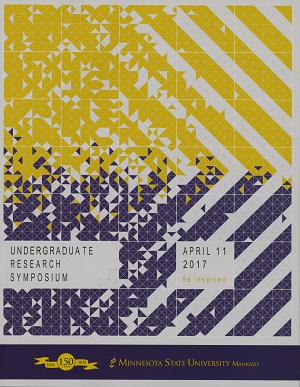Gamma Radiation Effects on the Mortality and Fertility Rates of Drosophila Melanogaster
Location
CSU Ballroom
Start Date
11-4-2017 10:00 AM
End Date
11-4-2017 11:30 AM
Student's Major
Physics and Astronomy
Student's College
Science, Engineering and Technology
Mentor's Name
Andrew Roberts
Mentor's Department
Physics and Astronomy
Mentor's College
Science, Engineering and Technology
Description
We analyzed the effects of mild radiation doses on Drosophila melanogaster by using the known characterization of the radiation dose rate produced by the AN 400 Van de Graaffe Particle accelerator in the Applied Nuclear Science Lab at Minnesota State University, Mankato. The purpose was to see how well we could deliver consistent, controlled, and reproducible radiation doses to the fruit flies over extended periods of time. By performing proper methods of conditioning we were able to irradiate the organisms on the hot spot at an approximate 1 R/hr and also produced a maximum dose rate of 1500 mR/hr at the hot spot. Examination of the controlled and irradiated populations of the Drosophila melanogaster began once the tested group had been exposed to 10 rads of positive ion beam emissions. Our population analysis, over the course of many trials of radiation exposure to the fruit flies, consisted of investigating biological factors such as mortality rates, fertility rates, and other physical abnormalities found after successive generations being irradiated.
Gamma Radiation Effects on the Mortality and Fertility Rates of Drosophila Melanogaster
CSU Ballroom
We analyzed the effects of mild radiation doses on Drosophila melanogaster by using the known characterization of the radiation dose rate produced by the AN 400 Van de Graaffe Particle accelerator in the Applied Nuclear Science Lab at Minnesota State University, Mankato. The purpose was to see how well we could deliver consistent, controlled, and reproducible radiation doses to the fruit flies over extended periods of time. By performing proper methods of conditioning we were able to irradiate the organisms on the hot spot at an approximate 1 R/hr and also produced a maximum dose rate of 1500 mR/hr at the hot spot. Examination of the controlled and irradiated populations of the Drosophila melanogaster began once the tested group had been exposed to 10 rads of positive ion beam emissions. Our population analysis, over the course of many trials of radiation exposure to the fruit flies, consisted of investigating biological factors such as mortality rates, fertility rates, and other physical abnormalities found after successive generations being irradiated.
Recommended Citation
Pouliot, Wyatt; Curran Couchman; Jacob Bukkila; and Nicholas Miller. "Gamma Radiation Effects on the Mortality and Fertility Rates of Drosophila Melanogaster." Undergraduate Research Symposium, Mankato, MN, April 11, 2017.
https://cornerstone.lib.mnsu.edu/urs/2017/poster-session-A/50



